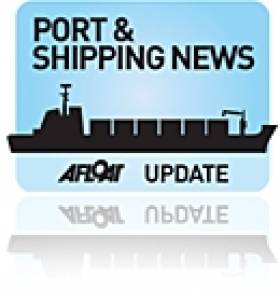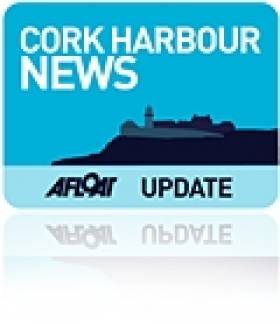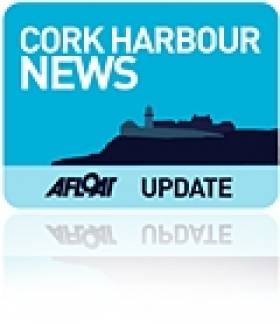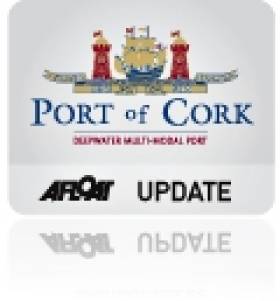Displaying items by tag: port of Cork
#CustomHouse - Port of Cork Company's historic city-centre Custom House according to the Irish Examiner is set to be put on the market in the coming weeks as it advances plans to relocate to Ringaskiddy.
The building will be brought to market with a guide price expected to be in the region of €6m but could yet fetch significantly more than that given demand in the docklands area. Sources estimated its eventual price tag could reach as much as €10m.
The 19th century building should prove a major attraction to potential investors given its prominence in the city and rising demand in its vicinity. The building was taken over by the Harbour Commissioners in 1904 on a 999-year lease before the Harbours Act of 1996 transferred all the Commissioners assets to the Port of Cork.
To read more on recent property sales close to the Custom House and a new downriver central business district (CBD) click here.
2015 A Significant Year for Port of Cork Company
#PortofCork2015 - The year 2015 has been significant for the Port of Cork Company in many ways. Trade traffic has been performing well and according to the company, well over €8 million tonnes of cargo moving in and out of the port to date (full year trade figures will be available in early January 2016.)
Earlier in the year, the Port of Cork was granted planning permission for the Ringaskiddy Port Redevelopment which was a great achievement for the Port of Cork and particularly the Munster region.
According to Mr Brendan Keating, Chief Executive of the Port of Cork Company, securing this future development translates into significant economic benefits for Cork and the Munster region, as well as the national economy.
Following a public tender process in November, advance works on the project are due to begin in January 2016. These advance works are a positive step in terms of the Ringaskiddy port redevelopment and will include site clearance to the proposed container compound area which will serve to prepare the site to ensure the main works are not delayed.
Mr Keating commented on the advance works saying: ‘This is a very positive initial step of the project and will ensure the next step, which is to launch the main works contract in April 2016 will be on track, with a view to contract being awarded in Q3 2016.’
He continued: ‘It is estimated that 849 FTE jobs will be created during the construction of the Ringaskiddy Redevelopment Project which the Port aims to have operating by Q4 2018.’
The Port of Cork cruise business has been a success story from the early 1990’s when the port welcomed 10 cruise ships per year to Cork Harbour compared to over 60 cruise ships now annually. Over 100,000 passengers and crew visit the region on board these luxurious liners and in turn provide a huge boost to the local economy. This year the Port of Cork have invested €1.5 million in upgrading facilities at Cobh Cruise Terminal, Ireland’s only dedicated cruise berth, which will enable larger ships to be berthed.
Cork’s cruise business success is down to a number of things, such as year round marketing of the port’s capabilities and what the region has to offer, continued investment by the Port in the cruise area and a dedicated team, eager to increase business and make Cork Ireland’s number one cruise destination.
In 2015 the Port of Cork together with Cunard, marked the 100th anniversary of the sinking of RMS Lusitania. This commemoration, which was attended by the President of Ireland showed Cobh town in all its glory and particularly highlighted Cobh’s maritime history and indeed Cork Harbour’s history
‘Cork Mega Port’, the fly on the wall style documentary series produced by Goldhawk Media gave viewers all over Ireland an opportunity to go inside the day to day workings of the Port of Cork. This hugely successful TV series was a unique opportunity for the Port of Cork and highlighted the many challenges faced by port staff to ensure Cork’s trade is kept moving 24/7 365 days a year.
Summarising 2015 for the Port, Chief Executive Mr Brendan Keating said: ‘Every year we face challenges as a port company, however receiving planning permission for the Ringaskiddy Port Redevelopment has given our organisation a renewed confidence in the future of trade for the Cork region. Not only is this a boost for our company but most importantly for our customers, who can now confidently plan for the future, knowing the port will be here to accommodate their needs.’
Bureau Veritas Issues International Pilotage Certification to Port of Cork
Leading classification society Bureau Veritas has issued its first certificate under the ISPO (International Standard for Maritime Pilot Organizations) standard of best practice for pilots and pilot organizations to the Pilotage Authority, Port of Cork, Ireland. The ISPO certification covers the Pilotage services and Vessel Traffic Management System.
The ISPO is an accessible industry specific standard, managed by a group of users, that improves safety and quality and provides transparency to ship owners and stakeholders on pilotage standards.
Philippe Donche-Gay, Executive Vice-President and Head of Bureau Veritas Marine & Offshore division, says, “The Port of Cork has adopted this industry code as a means of building continuous improvement into its pilotage operations. Bureau Veritas is pleased to be able to audit the pilotage and support this initiative. It is part of our own continual drive to support and deliver services which help ship owners and the marine community operate more effectively.”
Paul O’Regan, Harbour Master, Port of Cork, says, “Port of Cork Pilots has always been at the forefront of the industry when adapting to change and in consistently achieving the highest levels of safety and operational standards. The accreditation by Bureau Veritas from ISPO recognises the fact that the Cork Pilots and Pilotage Authority have, for many years, had a systematic approach to achieving first class port operations. The Port Company and Cork Pilots have worked hard with BV over the last twelve months in order to meet the requirements of ISPO and I believe this standard will achieve global recognition. The pilots and ports that achieve ISPO will be best placed to meet the needs of our maritime customers.”
The ISPO certification for the Port of Cork covers twelve pilots which safely managed mixed marine traffic handling over 9 million tonnes of cargo and 56 cruise ship calls during 2015.
Mv Boudicca Cruises Into The Port Of Cork For Final Call Of 2015
The Port of Cork will welcome MV Boudicca, the final cruise liner of the 2015 season to Cobh tomorrow following another very successful cruise season for the Port of Cork.
2015 has been the most significant year to date for the Port of Cork, not in the number of ships but in their increased passenger carrying capacity. In total, 55 cruise liners called to the Port of Cork, home to Ireland’s only dedicated cruise berth, carrying a record 145,000 passengers and crew. These visitors bring a much needed boost to the local economy for eight months of the year.
In 2015, 10 liners made their maiden call to the Port of Cork and 20 vessels called which were greater than 330 metres in length and carried in excess of 3,000 passengers.
The continuing trend with the major cruise lines is for bigger vessels of 300-350 metre lengths and a capacity of 3,000 – 5,000 passengers. Captain Michael McCarthy, Commercial Manager of the Port of Cork commented: “if Ireland aspires to grow its cruise sector and capitalise on this continuing expansion, the main cruise regions of Dublin, Cork and Belfast will need to review their cruise strategy and upgrade their berthing options. The cruise companies has confidence in the sector as is evident from their investment so it is now time for the EU, Irish Government, regional authorities, chambers and tourism bodies to have equal confidence in the sector and back the necessary infrastructure. The cruise sector is unique in that the cities and regions are the main beneficiaries of cruise calls with an estimated spend of €15m in the south of Ireland alone this year from vessels visiting Cork Harbour”.
Earlier this year, the Port of Cork invested over €1.5 million in upgrading facilities at Cobh Cruise Terminal, with the installation of a number of high load 150 tonne mooring bollards which will enable even larger ships to berth into the future. Construction was complete by mid-April 2015, in time for the start of the 2015 cruise season which got underway with the berthing of the “Regal Princess” on the 25th April. The Port of Cork Company is committed to developing the cruise business into Cork and this upgrade of the cruise berth will ensure that Cobh and Cork Harbour can accommodate the largest vessels visiting Europe for the foreseeable future. The Port of Cork’s dedicated cruise berth offers a genuine unrestricted berthing at any stage of the tide on a 24/7 schedule. The booking schedule for 2016 looks very promising and the Port expects to considerably increase the number of calls and passengers to the region.
Following this excellent cruise season, the Port of Cork would like to express their thanks to all their Cork Cruise members, Irish Rail, tourist ambassador volunteers, Cobh Tidy Towns, tour operators, bus companies, travel agents and the many different attractions around the region for their continued support and cooperation with the cruise business.
EU Funding For Irish Port Projects Will Bring Significant Infrastructural Benefits - Donohoe
#IrishPorts - Transport Minister Paschal Donohoe has today (Friday 10 July) welcomed the announcement by the European Commission that a number of projects – including developments across three Irish ports – have been recommended for co-funding under the Connecting Europe Facility (CEF).
"This is good news and a further boost for infrastructure investment in Ireland," said Minister Donohoe. "The recommendation by the European Commission in respect of these five projects is a positive step in the development of these key infrastructural projects which will allow for future growth and development which will ultimately help with job creation.
“I was particularly delighted to support the port companies in their applications. Ireland’s National Ports Policy categorises the Port of Cork Company, Dublin Port Company and Shannon Foynes Port Company as Ports of National Significance (Tier 1) in recognition of the key role of they play in national economic development.
"This positive announcement will support significant, planned investment by the ports and follows the news that the Ringaskiddy project in the Port of Cork has recently been granted planning permission, while just today the Alexander Basin Redevelopment Project received a positive planning decision from An Bord Pleanála, allowing the largest ever infrastructure development project to be carried out at Dublin Port.
"In addition, Shannon Foynes Port Company’s first major project, the redevelopment of the East Jetty, is now well underway having commenced earlier this year. The continued commercial development of the port companies is a key strategic objective of the Government which will support job creation across the country as they are progressed in the years to come.”
The five projects are as follows:
· Port of Cork, Ringaskiddy Project (Project Type: Works, Co-funding rate: 17.47%, EU Max Contribution: €12,736,001.10)
· Shannon Foynes Port Company, Jetty Enhancement for Sea Port (Works, 20%, €2,200,000)
· Shannon Foynes Port Company, Connecting International Sea Cargo to the Irish Rail Network (Study, 50%, €800,000)
· Dublin Port, Alexandra Basin Redevelopment Project (Works, 10.3%, €22,782,055)
· City Centre Re-signalling Project (Works, 30%, €17,586,760.20)
EU Funding Endorses Port of Cork Ringaskiddy Development
#portofcork – The Port of Cork has secured EU funding from the Connecting Europe Facility (CEF) – Transport sector. As a Trans-European Transport Network (TEN-T) project, over €12.3 million was allocated for the Port's Ringaskiddy Redevelopment Project, further endorsing the Port of Cork as a vital link in the European transport network.
The Ringaskiddy Redevelopment Project, which will ultimately amount to an investment of around €100 million, will form an extension to the existing facilities that the Port currently operates in Ringaskiddy.
Speaking about the funding investment secured from the EU, Mr Denis Healy, Manager Engineering Services, Port of Cork said: "This funding will assist in ensuring the Port of Cork can meet future connectivity needs and will support the development of the wider regional and national economy which is of key importance to Cork."
He continued: "The funding will be invested in the first phase of the Ringaskiddy Port Redevelopment Project which was given the green light by An Bord Pleanala in May."
Launched in September 2014, the Connecting Europe Facility (CEF) call for proposals generated an unprecedented interest. The Commission received 700 applications totalling €36 billion of requested funding, three times more than the available envelope. This allowed the Commission to select the projects with the highest European added value, while guaranteeing a balanced distribution geographically and between the transport modes.
#ringsakiddy – The Port of Cork has welcomed the decision of An Bord Pleanála to grant planning permission for the Ringaskiddy Port Redevelopment project in the lower harbour. The development, which will ultimately amount to an investment of around €100 million, will form an extension to the existing facilities that the Port currently operates in Ringaskiddy.
Brendan Keating, Chief Executive of the Port of Cork said that while the decision and the conditions it entailed need to be considered in more detail, the Port is very pleased with the overall go-ahead from An Bord Pleanála. "Being able to accommodate larger vessels is of utmost importance if the Port of Cork is to remain competitive and continue to meet the needs of our customers and the economic developmental needs of the region. Today's decision will enable us to do this and in turn, future proof Cork as an international gateway for trade."
"We are conscious of the concerns raised by the residents of Cork harbour, particularly those raised at the oral hearing last September. We will be consulting further with residents and with all harbour users in relation to the development."
Securing future development potential for the Port of Cork, translates into significant economic benefits for Cork and the Munster region, as well as the national economy. 98% of goods imported or exported from Ireland are moved by ship, amounting to over €14 billion annually in Cork alone, highlighting the importance of ports to our economy.
This development is the first phase of the implementation of the Port of Cork's Strategic Development Plan Review (2010), the core principles of which were endorsed in the National Ports Policy, which highlighted Cork as a Tier 1 port of national significance.
Phase 1 of the Ringaskiddy Port Redevelopment project is expected to be operational in 2018. The overall project will facilitate, on a phased basis, the Port of Cork in transferring cargo handling activities from Tivoli and the City Quays in due course.
#lusitania – President Michael D Higgins will lead a commemoration event in Cobh on Thursday, 7th May to mark the centenary of the sinking of the Lusitania. The event, which will also be attended by a number of other VIPs including the British, German and US ambassadors to Ireland is expected to see a large turn-out and the public are advised that traffic and parking restrictions will be in place throughout the day.
Road closures will be in effect in Casement Square and on part of Westbourne Place from 11.30am until 10.30pm.
Captain Michael McCarthy, Commercial Manager of the Port of Cork who is lead organiser of the event said "We expect that up to 10,000 people from across Ireland and beyond, many of whom have personal connections to the Lusitania disaster, will descend on the town of Cobh to remember all those who lost their lives on the 7th May 1915. For anyone intending on travelling to the event, I would urge them to take the train as it is the easiest and most direct way to get to the heart of Cobh town where events will be taking place."
Irish Rail will be running additional services throughout the day on the Cork - Cobh line giving a service every 30 minutes from 06.30hrs until 19.30hrs. Cobh can also be accessed from stations at Midleton, Carrigtwohill, Little Island and Glounthaune, where free parking is available. For train timetables and for further information, please see www.irishrail.ie
Superintendent John Quilter said "Additional Gardaí will be in place for the day and will be aided by event stewards to ensure that everyone who attends has an enjoyable and safe experience. I would encourage all those travelling to Cobh to plan their travel in advance and to check for updates in relation to parking and traffic restrictions."
The main points are as follows:
· No parking at Westbourne Place and Casement Square.
· One way system going into Cobh along the High Road.
· One way system going out of Cobh along the Lower Road.
· Disabled parking is outside the Sirius Arts Centre on Lower Rd. – display badge and follow signage.
· Obey Directions of Gardaí and stewards at all times.
· Secure vehicles and don't leave valuables in them.
· Where applicable, display parking badges clearly en route to the event.
· Parking will be available at the Verolme Cork Dockyard adjacent to Rushbroke rail station. Additional parking will be available at Cobh Pirates Rugby Club and the Cathedral car park.
The Cross-River Ferry will run two vessels throughout the day for those travelling from the west side of the harbour.
#portofcork – The Port of Cork today outlined plans for Phase 1 of the Bantry Inner Harbour Development which the Port of Cork will undertake on behalf of its subsidiary company, Bantry Bay Port Company.
The scheme marks the start of the regenerating of the inner harbour and is in keeping with the total Inner Harbour Development scheme which was developed by the Bantry Bay Harbour Commissioners in 2012 and planning permission was granted in 2013.
Now being advanced by the Bantry Bay Port Company, the scheme will provide a more sheltered harbour environment and marina with increased water depth and improved pier facilities which will promote fishing and tourism activities in the Bantry area.
Phase 1, which is likely to cost €8.5m, will consist of the following principal elements:
· 20 berth Marina (quayside pontoons)
· Dredging to a depth of 4 metres to allow vessels access to the inner harbour
· Remedial works to Town Pier (widening and extending)
· 4,000m2 of reclaimed landscaped amenity area
· Construction of 60m long floating breakwater pontoon
· Beach nourishment at Cove site
Commenting on the development, Brendan Keating, Chief Executive of the Port of Cork said that there are many benefits for Bantry and the wider Harbour area in undertaking such a project. "Works to the Town Pier will ensure improved longevity of the existing pier structure and improved access and facilities on the pier will facilitate existing activities and hopefully generate more commercial activity for Bantry Harbour. There will be improved berthage available for larger marine vessels and the Company would hope that this will lead to an upturn in marine leisure in and around Bantry Harbour" he said.
It is expected that construction will commence on the project in Q4 2015 and will be complete in Q1 2017. The work will be phased in order to minimise impacts to pier operations and to minimise traffic and amenity impacts for the town.
Bantry Bay is the largest of the long marine inlets in south-west Ireland. It is approximately 35 km long, running in a south-west to north-easterly direction. The entrance to the bay is approximately 10 km wide, steadily narrowing to 3-4 km at its head. Bere Island, situated on the north shore adjacent to CastletownBere, and Whiddy Island lying near the head of the bay on the southern shore are the two largest islands in the bay.
Port of Cork Seeks Development Engineer
#portofcorkengineer – The Port of Cork has advertised for a Project and Development Engineer to mange its engineering services. The position requires a leader with a civil engineering degree and ten years post graduate experience. The role is advertised intoday's Irish Times newspaper. A copy of the advert is downloadable below.

































































